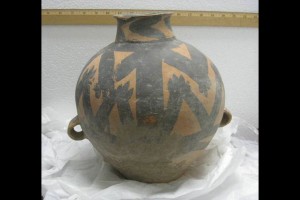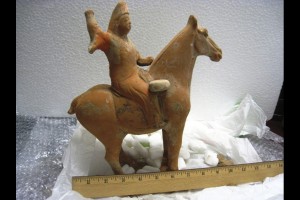Federal agents from Homeland Security and Customs and Border Protection officers confiscated two ancient Chinese artifacts that were being smuggled into the country through Newark Liberty International Airport. One is a 5,000-year-old prehistoric pot, the other a Tang Dynasty (618-907 A.D.) horse-and-rider figurine. Both are in excellent condition.
“The illegal trade of cultural antiquities is one that affects us all,” U.S. Customs Director Robert E. Perez said in the statement. He said the joint team is “dedicated to intercepting these items and ensuring their safe return to their rightful owners.”


Customs and Border Protection have seized five other stolen Chinese artifacts in New York and New Jersey just over the past year. The Chinese antiquities market is very hot right now thanks to the recent proliferation of moneyed Chinese buyers looking to reclaim cultural patrimony looted during foreign invasions and revolutionary fervor. It makes sense that the black market trade in smuggled stolen goods would be hot right now too.
Also, last year the United States and China signed a Memorandum of Understanding agreeing to step up efforts on both sides to stem the illicit trade in Chinese antiquities.
The trade agreement restricts the importation to the U.S. of cultural and archaeological materials from the Paleolithic through the Tang Dynasty (75,000 B.C.–A.D. 907), as well as monumental sculpture and wall art at least 250 years old. (A detailed list was published by the Department of Homeland Security and the Department of the Treasury in the Federal Register on January 16, 2009.) Such archaeological material originating in China can only come into the U.S if accompanied by a valid export permit or other appropriate documentation from the Chinese government.
In addition to the import restrictions, the MOU requires that both countries take a number of steps. China, for example, pledges to expand efforts to educate its citizens about the importance of safeguarding its rich cultural heritage, to increase funding and other resources for protecting cultural heritage, and to block looted artifacts from entering the Hong Kong and Macao Special Administrative Regions, where much of the material currently comes onto the art market. The U.S. pledges technical assistance to China in protecting its cultural heritage. The agreement also outlines steps to foster loans to museums in the U.S., scholarly collaboration among archaeologists from both countries, and exchange of faculty and students. Both countries commit to educating their customs officers about cultural heritage and Chinese archaeological material. Both agree to share information that helps enforce applicable laws and regulations to reduce illicit trafficking in cultural property.